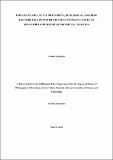| dc.description.abstract | African animal trypanosomiasis is a neglected tropical disease with significant impacts on
pastoral community livelihoods. This study sought to determine the influence of seasonal
cattle movements and risk factors including age, sex, and herd size and treatment
intervention, in conjunction with studying ecological factors on trypanosome infections in
cattle in of the Maasai steppe in northern Tanzania. To identify potential hotspots areas of
trypanosome transmission and associated ecological factors, I worked with five pastoralist
households in each of three study villages in the Maasai steppe. Consecutively, 10 individual
cattle were sampled in three periods, covering both wet and dry months grazing ranges (July,
2017 to January, 2018). Each time a blood sample was collected from the cattle, a
prophylactic dose of diminazene aceturate was administered to clear any trypanosome
infections acquired in the previous three months. Participatory mapping techniques were then
used to identify the areas in which each pastoralist had grazed their herds since the last
sampling period. Herders were also interviewed about the presence of cultivated farms and
other habitat types observed in grazing areas, the abundance of wild animals per visit, risk
factors related to the cattle, previously infected cattle and any disease control methods they
had practiced since my last visit. Trypanosome infections in the blood sample were detected
using nested polymerase chain reaction with ITS-1 primers. The overall prevalence of
trypanosome infections across all sampling periods and villages was 13.1%. Prevalence in
July, 2017 (19.3%) was significantly greater than prevalence in October, 2017 (2%) (P<0.05).
Cattle acquired trypanosome infection in 21 out of 45 grazing areas identified. Herd sizes
between 51-100 cattle were observed to be positively associated with the prevalence of
trypanosome infections in different villages. Wild animal abundance particularly buffaloes
together with their habitat types, notably woodland, were observed to be positively associated
with trypanosome infection while cultivation was negatively associated with trypanosome
infections. Targeted awareness on influence of seasonality, hotspot areas, risk factors,
ecological factors and cultivation of trypanosome infections will help Maasai pastoralists to
plan movement of their cattle strategically, properly controlling and avoiding disease risks. | en_US |


